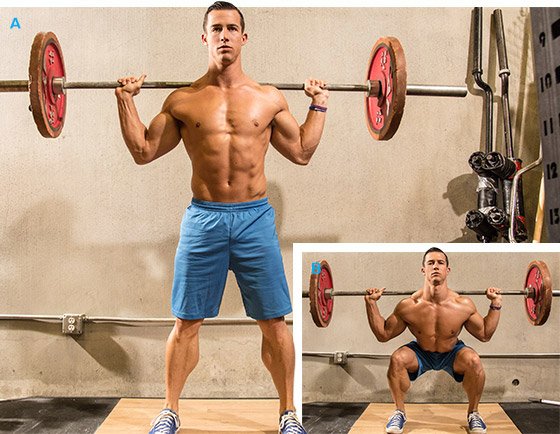Hey, you!
Yeah, you, the one struggling to hit a new personal bench press record by lifting heavy week after week. Sure, I get it. Multiple plates make anyone look like a badass, but despite trying to lift heavier and heavier, the results just don't seem to add up. Experienced trainees in particular will find it more and more challenging to hit loftier numbers.
Here's a thought: How about you stop focusing solely on moving heavy weights as a way to get stronger. Try supplementing your strength training program with the following modes of non-heavy weight training.
1. INCORPORATE LIGHT BAR SPEED WORK
The idea of not lifting heavy may sound blasphemous, but research has shown that lifting lighter may be just as effective as going heavy and hard for building strength. This is not to say that you—especially if you're an advanced and experienced lifter—should use only baby weights from now on. Try speed work.Speed work refers to a type of strength training which uses a much lower percentage of your maximal weight. Lifting weights with greater bar speed trains your stretch reflex and your ability to build momentum more quickly, as well as recruit more muscle fibers. This type of training benefits athletes whose sports involve generating a huge amount of force in as short a time as possible.
Also known as explosive strength, speed work typically involves lifting weights at 45-65 percent of your 1-rep max for 2-6 reps per set as explosively as possible. To get the most out of this speed work, you need to treat each rep as if you're pushing max effort; pick up or push the weight really, really fast or in an explosive manner on the upward motion—of a squat, for example.
Imagine you are doing speed squats. Descend quickly into the hole, pause briefly, and then shoot back up as powerfully and quickly as you can while maintaining proper squat form. Just because the weight is lighter doesn't mean you slack off on form. On the contrary, this is the best time to hone in on your technique. Since speed work hits both lower-than-max weight and reps, you'll benefit from more total sets than a typical heavyweight rep scheme, equating to a higher volume of work (typically 12 sets).
Plyometrics and Olympic lifts can also help in the same way as speed work, but it should be important to build upon your explosiveness in more relevant areas. A clean and jerk, for example, probably won't do much to build your bench press, whereas plyometric push-ups will.
2. SPRINT YOUR WAY TO GAINS
In this context, work capacity refers to the degree in which you can or cannot maintain repeated bouts of high intensity (e.g. how many sets and reps can you take above 90 percent effort?). Improving work capacity in regard to strength training is a fancy way of saying, "Duh, do more sprint work."Sprinting is the anabolic—or musclebuilding—form of cardio which develops your cardiovascular health, while keeping strength and muscular growth. It reduces impact by reducing running time (as compared to traditional long-distance running), but it should be extremely intense.
Sprinting should complement your training program, but not make you so fatigued that the rest of your training suffers. While you can sprint on a track, cycling can also be an option if your goal is to gain muscle mass, since it doesn't burn as many calories as running. You can get a lot of quality anaerobic work on a prowler or sled, if you have access to that special equipment.
Avoid doing cardio on the same day as a heavy lifting session (or at least not on the same day as a lift you care about), and make sure you get enough sleep and calories to maximize recovery.
You can see great benefits from one or two sessions of sprint intervals or high-intensity interval training (HIIT) each week.
3. GET MORE LEAN MUSCLE MASS
Composition refers to the ratio of your fat mass to lean mass. Ideally, you'd aim to pack the most possible muscle on your frame and get stronger for your relative size.This is relevant because common sense says that—with all things being equal—a person with more muscle tends to be stronger than someone with less.
To this end, training in bodybuilding-style 8-12 rep schemes and reeling in a tighter line on your diet (count your macros every now and then!) could help you cut out the excess fat and maximize your strength potential per pound.
You'll still want to do a lot of work with your main lifts, but you'll also need to do isolation-style exercises to ensure maximum hypertrophy as well.
PUTTING IT TOGETHER
In order to harness your full strength potential, you will need to incorporate speed work and sprints, and improve your amount of muscle per pound of body weight to help build strength. By going (and being) lighter, you can get faster and stronger.Other strength programs might rotate between heavy, speed, and bodybuilding days, while also including assistance work and cardiovascular training on off days. For best results, lifts should be tested in a variety of styles—variations on form, loading patterns, and lifts which identify muscular weaknesses—to help break through any personal weak points. An example of this is working on hamstrings to help improve squats.
Find the right balance here and you'll soon find that the only problem you have with strength training is that too many of your friends will start asking you to help move couches around.
Source: http://www.bodybuilding.com/fun/3-ways-to-gain-strength-without-lifting-heavy-weights.html



0 comments:
Post a Comment